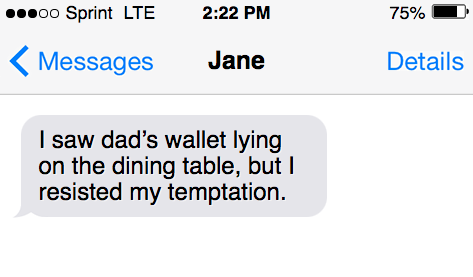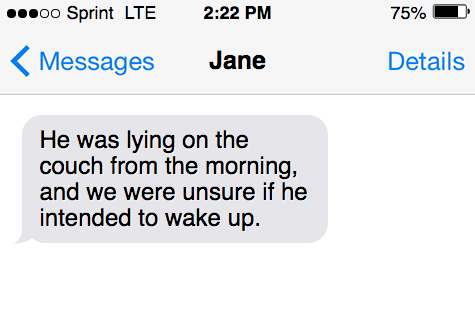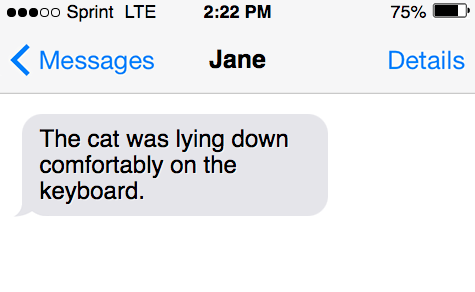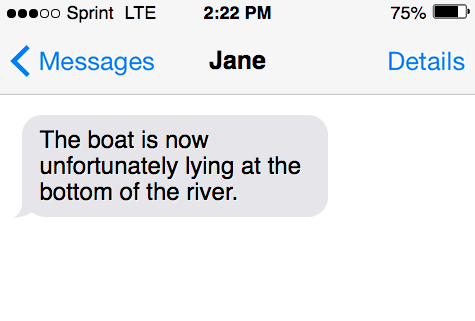Laying and lying are words derived from the words lay and lie respectively. Most people are confused about how to use these two words and more importantly when to use them. It is common to see people using ‘lay’ when ‘lie’ should be used and vice-versa.
The difference between the two is quite simple. The word laying requires a direct object. You are laying something down. (eg: laying a book down). Lying, on the other hand, means being in a horizontal position (eg: lying on the floor).
We look at the difference between these two words in detail. The examples given will help you clearly understand when to use which word.

What does “laying” mean?
Laying is derived from ‘lay’. In simple terms, it means putting something somewhere. To understand its meaning, we must look at its root ‘lay’. The word lay means ‘put down something.’ The key here is ‘something’. The verb laying requires a direct object to put down. You are laying, putting down, or placing an object.
Laying can also refer to setting down something. Usually, it is indicative of putting an object in a state of rest. An example will help understand it better.
- He is laying down the plates on the dining table.
In the above, the verb laying is related to the object plates. The plates are being placed on the dining table. Once it is placed, the plate lies at rest until it is moved again.
“The hen is laying eggs” is another example. The hen is producing eggs, that are falling on the ground. To use the verb ‘laying’, there must be an object directly associated with it.

What does “lying” mean?
While laying has one straightforward meaning, the verb lying has two meanings. Lying refers to being in a horizontal or prone position.
For example, ‘She was lying down in the morning as she had a headache.’ If you observe this sentence, no direct object is associated with it. The sentence does not say whether she was lying on the ground, in bed, or anywhere else.
Lying is the right word choice in this sentence because the person is in a recumbent position, not an object.
There is another meaning of lying, which is telling a falsehood or untruth. E.g., He was lying when he said that he got a new job. This meaning of the word is pretty straightforward and unlikely to confuse.
| Word | Definition |
| Laying (verb) /lā/ | put down, especially gently or carefully. |
| Lying (present participle of lie) /ˈlīiNG/ | present participle of lie. |
Difference between “laying” and “lying”
Confusion arises when both laying and lying are used to denote a horizontal position. The difference is very clear. Laying requires a direct object.
It refers to an object being laid down or placed somewhere.
On the other hand, lying refers to a person or thing assuming a position of rest or a horizontal position.
Understandably, people get confused while using these two terms. The reason for this is that both words look similar.
Though they are spelled differently, people believe both mean the same thing. Both lay and lie refer to being in a state of rest. However, the critical difference is lay refers to an object, while lie does not.

Laying is the act of putting an object down while lying is assuming a horizontal or prone position.
- He is laying down the books on the floor.
- He is lying down.
The above examples would make it clear. In the first sentence, the person is doing an action: laying or placing the object (books). In the second sentence, a person is resting or recumbent. You must note there is no need to specify an object in case of ‘lying’. It could be ‘lying’ anywhere – floor or bed or sofa.
Lying can be used independently, but laying requires an object (that which is being placed or put down).
Here is a simple trick that will help you understand when to use which word.
- Lay is related to pLAce.
- Lie is related to RecLIne.
If you are using the verb to mean placing something somewhere, then lay is the right word to use. If your intention is to use the word to mean recline, then lie is the word to use.
Understanding tenses of “laying” and “lying”
It’s now time to look at the different tenses of laying and lying. Let’s start with the root verbs lay and lie.
Let’s look at laying.
- The present tense is lay. (Example: Lay the box down)
- Laying is the present participle. (Example: He is laying the box down)
- The past tense is laid. (Example: He laid the box down)
- Past participle is also laid. (Example: He had laid the box down).
Now let’s look at the tenses for lying.

(Note: We are not referring to the meaning that indicates telling an untruth).
- The present tense is lie. (Example: You should lie down for some time).
- The present participle is lying (Example: You have been lying down from some time).
- Lay is the past tense (Example: You lay down from some time).
- The past participle is lain (Example: You have lain down from some time).
We must note here the past and past participle tenses are where people get confused. The past tense of laying is lay and the past participle has lain. People use ‘lied’ which is wrong. Here ‘lied’ means telling something false.
When to use “laying”
The word laying is to used when there is a direct object associated with it. Keeping in mind the trick mentioned above, use lay when you are placing something.
When a person is resting or in a recumbent position, lying is the word to be used, not laying. Use laying only when there is a direct object involved that is being placed.
Sentence examples
- The electrician was busy from the morning laying cables underground.
- The farmer stood impatiently watching his hen laying eggs.
- Clara is laying the newspapers on the director’s table.
- I am laying all the books on the dressing table.
- My parents believe in laying down the law at home.
When to use “lying”
Lying is to be used when someone or something is in a position of rest or in an incumbent position. As per the trick mentioned above, lying is associated with reclining.
The word lying does not have a direct object. This means that some object needs to be present to ‘lay.’ But while lying, a direct object is not necessary. Where a person or thing is lying may or may not be mentioned.
Sentence examples
- I saw dad’s wallet lying on the dining table, but I resisted my temptation.
- He was lying on the couch from the morning, and we were unsure if he intended to wake up.
- The cat was lying down comfortably on the keyboard.
- I was shocked to find John lying on the ground, with the injury oozing from his head and nose.
- The boat is now unfortunately lying at the bottom of the river.
Is it “lying down” or “laying down”?
Let’s try to answer this question logically. You are lying down whereas you lay down something. As per the rule discussed above, the word laying requires a direct object.
In lying down, there is no direct object involved. You may lie down on the floor or the bed, but that is not a direct object.
When lay down is used, you are laying or placing something. That something is the direct object, which is required to use laying. In this case, there is no mention of any object.
So, laying down is not the proper usage. The correct usage is ‘lying down.’
You will use this in a sentence as ‘He is lying down’ or ‘I am lying down’. The sentence indicates that you or someone else is resting.
If you use ‘He is laying down’, then the sentence is wrong because it is incomplete. The question arises, what is he laying down?
Since laying requires an object that is not specified, this usage is wrong.
Laying down can be used only when an object is mentioned.
Example: Laying the books down or laying the box down. Laying down the law is another example where ‘laying down’ can be used. But it is used by mentioning the object, which is the grammar rule.
Is it “laying around” or “lying around”?
Let’s go back to the golden rule as in the previous case. Laying is when a direct object is mentioned. Lying is when no object is mentioned.
If you use lay around, then there must be some object that you are laying on. Laying around is not the appropriate choice of words without mentioning the object.
When we look at lying around, it could refer to someone lying around. E.g., He is lying around the house since morning. Here the reference is to someone who is sleeping or resting from a long time. There is no object mentioned here.
Another use of this expression is in the sentence ‘He leaves the clothes lying around’.
This is the correct use since clothes are lying in a position of rest, and there is no object mentioned or required (i.e.: where is it lying).
Is it “laying on the ground” or “lying on the ground”?
Here again, you lay something on ground. If you want to use ‘laying on the ground’, there must be a clear and specific mention of what is it that you are laying on the ground.
If it was laying mats on the ground, then it would have been a correct usage.
Without the mention of the direct object, laying on the ground is a wrong expression.
It is obvious that lying on the ground is the right usage. The reference here is to someone or something lying on the ground. This is the correct phrase.
When we recall the trick discussed earlier, lay involve placing something.
Since that is not mentioned, it would not be right to use lay. Lie involves recline. Lying on the ground is reclining on the ground. So, this phrase is correct and can be used.
Sources
- Laying vs. Lying
- Laying vs. Lying (Lay vs. Lie) – What’s the Difference?
- Lay, Lie, Lied, Lain: When Do We Use Which?
- Laying vs. Lying: Which One Should You Use?
Inside this article
Fact checked:
Content is rigorously reviewed by a team of qualified and experienced fact checkers. Fact checkers review articles for factual accuracy, relevance, and timeliness. Learn more.
Core lessons
Glossary
- Abstract Noun
- Accusative Case
- Anecdote
- Antonym
- Active Sentence
- Adverb
- Adjective
- Allegory
- Alliteration
- Adjective Clause
- Adjective Phrase
- Ampersand
- Anastrophe
- Adverbial Clause
- Appositive Phrase
- Clause
- Compound Adjective
- Complex Sentence
- Compound Words
- Compound Predicate
- Common Noun
- Comparative Adjective
- Comparative and Superlative
- Compound Noun
- Compound Subject
- Compound Sentence
- Copular Verb
- Collective Noun
- Colloquialism
- Conciseness
- Consonance
- Conditional
- Concrete Noun
- Conjunction
- Conjugation
- Conditional Sentence
- Comma Splice
- Correlative Conjunction
- Coordinating Conjunction
- Coordinate Adjective
- Cumulative Adjective
- Dative Case
- Determiner
- Declarative Sentence
- Declarative Statement
- Direct Object Pronoun
- Direct Object
- Diction
- Diphthong
- Dangling Modifier
- Demonstrative Pronoun
- Demonstrative Adjective
- Direct Characterization
- Definite Article
- Doublespeak
- False Dilemma Fallacy
- Future Perfect Progressive
- Future Simple
- Future Perfect Continuous
- Future Perfect
- First Conditional
- Irregular Adjective
- Irregular Verb
- Imperative Sentence
- Indefinite Article
- Intransitive Verb
- Introductory Phrase
- Indefinite Pronoun
- Indirect Characterization
- Interrogative Sentence
- Intensive Pronoun
- Inanimate Object
- Indefinite Tense
- Infinitive Phrase
- Interjection
- Intensifier
- Infinitive
- Indicative Mood
- Participle
- Parallelism
- Prepositional Phrase
- Past Simple Tense
- Past Continuous Tense
- Past Perfect Tense
- Past Progressive Tense
- Present Simple Tense
- Present Perfect Tense
- Personal Pronoun
- Personification
- Persuasive Writing
- Parallel Structure
- Phrasal Verb
- Predicate Adjective
- Predicate Nominative
- Phonetic Language
- Plural Noun
- Punctuation
- Punctuation Marks
- Preposition
- Preposition of Place
- Parts of Speech
- Possessive Adjective
- Possessive Determiner
- Possessive Case
- Possessive Noun
- Proper Adjective
- Proper Noun
- Present Participle
- Prefix
- Predicate



